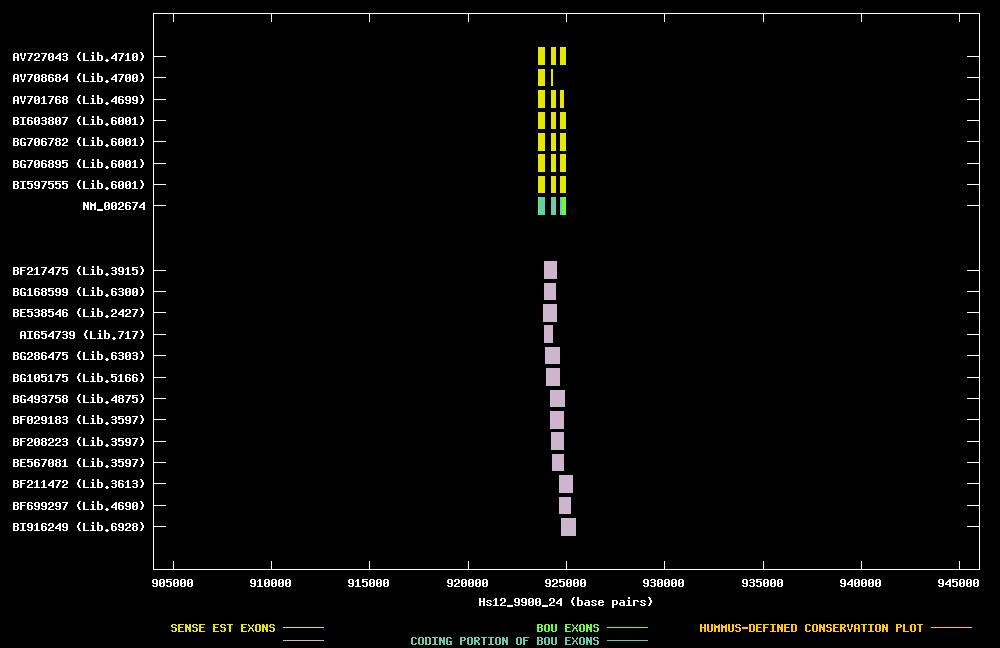









| Candidate UniGene cluster: | UniGene Cluster Hs.2182 |
| Description: | pro-melanin-concentrating hormone |
| Best-Of-UniGene (BOU) Sequence | NM_002674 |
| Genomic Coordiantes Displayed: | Bases 904000 to 946000 of contig Hs12_9900_24 |
| BOU Orientation Along Contig: | LEFT-TO-RIGHT with respect to contig |
| Link to JPEG of genomic mapping | Hs.2182.jpeg |
| Best sense EST/protein match: | NM_002674 matched ref|NP_002665.1| (NM_002674) pro-melanin-concentrating hormone [Homo sapiens] (E = 2e-90) |
| Best antisense EST/protein match: | BI916249 matched ref|XP_006589.1| (XM_006589) hypothetical protein FLJ20641 [Homo sapiens] (E = 1e-45) |

ANTISENSE ESTs
| BF217475 | cDNA clone IMAGE:4104350 | glioblastoma | 5' read |  | ||
| BG168599 | cDNA clone IMAGE:4455383 | hypernephroma, cell line | 5' read |  | ||
| BE538546 | cDNA clone IMAGE:3451706 | placenta | 5' read |  | ||
| AI654739 | cDNA clone IMAGE:2216389 | ovary | 3' read | 0.6 kb |  | |
| BG286475 | cDNA clone IMAGE:4500663 | transitional cell papilloma, cell line | 5' read |  | ||
| BG105175 | cDNA clone IMAGE:4422675 | adrenal cortex carcinoma, cell line | 5' read |  | ||
| BG493758 | cDNA clone IMAGE:4673043 | mucoepidermoid carcinoma | 5' read |  | ||
| BF029183 | cDNA clone IMAGE:3996887 | carcinoma, cell line | 5' read |  | ||
| BF208223 | cDNA clone IMAGE:4092169 | carcinoma, cell line | 5' read |  | ||
| BE567081 | cDNA clone IMAGE:3683483 | carcinoma, cell line | 5' read |  | ||
| BF211472 | cDNA clone IMAGE:4046722 | from chronic myelogenous leukemia | 5' read | |||
| BF699297 | cDNA clone IMAGE:4282647 | primitive neuroectoderm | 5' read | |||
| BI916249 | cDNA clone IMAGE:5242501 | brain | 5' read |
| BI597555 | cDNA clone IMAGE:5294709 | hypothalamus, cell line | 5' read |  | ||
| BG706895 | cDNA clone IMAGE:4794545 | hypothalamus, cell line | 5' read |  | ||
| BG706782 | cDNA clone IMAGE:4794845 | hypothalamus, cell line | 5' read |  | ||
| BI603807 | cDNA clone IMAGE:5286979 | hypothalamus, cell line | 5' read |  | ||
| AV701768 | cDNA clone ADBBQB10 | adrenal gland | 5' read |  | ||
| AV708684 | cDNA clone ADCAFH06 | adrenal gland | 5' read |  |